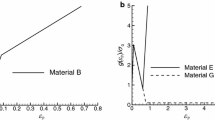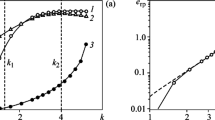Abstract
This paper provides a brief overview of the issues concerning the stress field singularity in a solid with a Griffith crack. A new model of the crack is proposed which takes into account the effect of the plastic deformation zone around the crack on the stress field in the solid. The stress field singularity arises as a special case when the curvature radius at the crack tip and the size of the plastic deformation zone around the crack reduce to zero. The model allows analyzing the influence of plastic strain gradients on the concentration and distribution of stresses at the crack tip. It is shown that the plastic strain gradient at the free surface of the crack is crucial for stress and strain calculations for a solid with a crack. An energy analysis is carried out for the fracture parameters of ductile materials with cracks. The derived equations can be used to evaluate the crack resistance of sufficiently ductile materials.






































Similar content being viewed by others
REFERENCES
Griffith, A.A., The Phenomenon of Rupture and Flow in Solids, Phil. Trans. Roy. Soc. Lond. A, 1920, vol. 221, pp. 163–98.
Griffith, A.A., The Theory of Rupture, in Proc. I Int. Congr. Appl. Mech., Biezeno, C.B. and Burgers, J.M., Eds., Delft: Technische Boekhandel en Drukkerij, 1924, pp. 55–63.
Inglis, C.E., Stresses in a Plate due to the Presence of Cracks and Sharp Corners, Trans. Inst. Naval Arch. Lond., 1913, vol. LV, pp. 219–230.
Orowan, E., Fracture and Strength of Solids, Rep. Progr. Phys., 1948, vol. XII, pp. 185–232.
Irwin, G.R., Fracture Dynamics, in Fracturing of Metals, Cleveland, USA: American Society for Metals, 1948, pp. 147–166.
Zhu, X-K. and Joyce, J.A., Review of Fracture Toughness (G, K, J, CTOD, CTOA) Testing and Standardization, Eng. Fract. Mech., 2012, vol. 85, pp. 1–46. https://doi.org/10.1016/j.engfracmech.2012.02.001
Irwin, G.R., Onset of Fast Crack Propagation in High Strength Steel and Aluminium Alloys, Proc. II Sagamore Ordnance Mater. Research Conf., 1956, no. 2, pp. 289–305.
Irwin, G.R., Handbuch der Physik, vol. VI, Berlin: Springer, 1958.
Irwin, G.R., Plastic Zone near a Crack and Fracture Toughness, in 7th Sagamore Ordnance Materials Research Conf., Syracuse: Syracuse Univ. Press, 1960.
Barenblatt, G.I., About Equilibrium Cracks Formed during Brittle Fracture. Rectilinear Cracks in Flat Plates, Appl. Math. Mech., 1959, vol. 23, no. 4, pp. 706–721.
Barenblatt, G.I., Mathematical Theory of Equilibrium Cracks Formed during Brittle Fracture, PMTF, 1961, no. 4, pp. 3–53.
Dugdale, D.S., Yielding of Steel Sheets Containing Slits, J. Mech. Phys. Solids, 1960, vol. 8, no. 2, pp. 100–104.
Leonov, M.Ya. and Panasyuk, V.V., Development of the Smallest Cracks in a Solid, Appl. Math. Mech., 1959, vol. 5, no. 4, pp. 391–401.
Panasyuk, V.V., Limit Equilibrium of Brittle Bodies with Cracks, Kiev: Naukova Dumka, 1968.
Brocks, W., Plasticity and Fracture. Solid Mechanics and Its Applications, vol. 244, Geesthacht, Germany: Springer Int. Publishing AG, 2018.
Broek, D., Elementary Engineering Fracture Mechanics, Leiden, 1974.
Harper, P.W. and Hallett, S.R., Cohesive Zone Length in Numerical Simulations of Composite Delamination, Eng. Fract. Mech., 2008, vol. 75, pp. 4774–4792. https://doi.org/10.1016/j.engfracmech.2008.06.004
Rezaei, S., Wulfinghoff, S., and Reese, S., Prediction of Fracture and Damage in Micro/Nano Coating Systems Using Cohesive Zone Elements, Int. J. Solids Struct., 2017, vol. 121, pp. 62–74. https://doi.org/10.1016/j.ijsolstr.2017.05.016
Sreeramulua, K., Sharmaa, P., Narasimhana, R., and Raja Mishra, K., Numerical Simulations of Crack Tip Fields in Polycrystalline Plastic Solids, Eng. Fract. Mech., 2010, vol. 77, pp. 1253–1274. https://doi.org/10.1016/j.engfracmech.2010.02.016
Elices, M., Guinea, G.V., Gomez, J., and Planas, J., The Cohesive Zone Model: Advantages, Limitations and Challenges, Eng. Fract. Mech., 2002, vol. 69, pp. 137–163.
Xie, D. and Waas, A.M., Discrete Cohesive Zone Model for Mixed-Mode Fracture Using Finite Element Analysis, Eng. Fract. Mech., 2006, vol. 73, pp. 1783–1796.
Lee, M.J., Cho, T.M., Kim, W.S., and Lee, B.C., Determination of Cohesive Parameters for Simulating Mixed-Mode Cohesive Zone Model, Int. J. Adhes. Adhesives, 2010, vol. 30, pp. 322–328. https://doi.org/10.1016/j.ijadhadh.2009.10.005
Yuan, H. and Li, X., Effect of the Cohesive Law on Ductile Crack Propagation Simulation by Using Cohesive Zone Models, Eng. Fract. Mech., 2014, vol. 126, pp. 1–11. https://doi.org/10.1016/j.engfracmech.2014.04.019
Gowrishankar, S., Mei, H., Liechti, K.M., and Huang, R., A Comparison of Direct and Iterative Methods for Determining Traction-Separation Relations, Int. J. Fracture, 2012, vol. 177, pp. 109–128. https://doi.org/10.1007/s10704-012-9758-3
Cornec, A., Scheider, I., and Schwable, R-H., On the Practical Application of the Cohesive Model, Eng. Fract. Mech., 2003, vol. 70, pp. 1963–1987. https://doi.org/10.1016/S0013-7944(03)00134-6
Caputo, F., Lamanna, G., and Soprano, A., On the Evaluation of the Plastic Zone Size at the Crack Tip, Eng. Fract. Mech., 2013, vol. 103, pp. 162–173. https://doi.org/10.1016/j.engfracmech.2012.09.030
Kirsch, E.G., Die Theorie der elastizität und die bedürfnisse der festigkeitslehre, Zeitschrift des Vereines Deutscher Ingenieure, 1898, vol. 42, pp. 797–807.
Mushelišvili, N.I., Some Basic Problems of the Mathematical Theory of Elasticity, Groningen-Holland: Noord Hoff Ltd., 1953.
Kelly, A., Strong Solids, Oxford: Clarendon Press, 1973.
Peterson, R.E., Stress Concentration Factors: Charts and Relations Useful in Making Strength Calculations for Machine Parts and Structural Elements, New York: Wiley, 1977.
Anderson, T.L., Fracture Mechanics. Fundamentals and Applications, Broken Sound Parkway, NW: Taylor & Francis Group, 2005. http://www.taylorandfrancis.com
Perez, N., Fracture Mechanics, Puerto Rico: Springer, 2004. https://doi.org/10.1007/978-3-319-24999-5
Hertzberg, R.W., Deformation and Fracture Mechanics of Engineering Materials, New York: John Wiley & Sons, 1976.
Eshelby, J.D., The Determination of the Elastic Field of an Ellipsoidal Inclusion and Related Problems, Proc. Roy. Soc. Lond. A, 1957, vol. 241, pp. 376–396.
Likhachev, V.A., Volkov, A.E., and Shudegov, V.E., Continuum Theory of Defects, Leningrad: Izd-vo Leningrad. Univ., 1986.
Мurа, Т., Micromechanics of Defects in Solids, Dordrecht: Martinus Nijhoff Publishers, 1986.
Markenscoff, X., Cracks as Limits of Eshelby Inclusions, Phys. Mesomech., 2019, vol. 22, no. 1, pp. 42–45. https://doi.org/10.1134/S1029959919010077
Deryugin, Ye.Ye., Lasko, G.V., and Schmauder, S., Relaxation Element Method, Comput. Mater. Sci., 1998, vol. 11, pp. 189–203.
Deryugin, Ye.Ye., Lasko, G., and Schmauder, S., Relaxation Element Method in Mechanics of Deformed Solid, in Oster Computational Materials, Wilhelm, U., Ed., Hauppauge, NY: Nova Science Publishers, 2009, pp. 479–545.
Timoshenko, S.P. and Goodier, J.N., Theory of Elasticity, New York: McGraw Hill, 1970.
Hahn, H.G., Elastizitatstheorie: Grundlagen der linearen Theorie und Anwendungen auf eindimensionale, ebene und räumliche Probleme, Stuttgart: B.G. Teubner, 1985.
Chen, Z., Gandhi, U., Lee, J., and Wagoner, R.H., Variation and Consistency of Young’s Modulus in Steel, J. Mater. Proc. Tech.,·2016, vol. 227, pp. 227–243.
Thompson, A., Substructure Strengthening Mechanisms, Met. Trans., 1977, vol. 6, pp. 833–842.
Troyansky, E.A. and Cholovsky, V.N., Increasing the Durability of Elements of Boiler Equipment, Moscow: Energoatomizdat, 1986.
Hirth, J.P. and Lothe, J., Theory of Dislocations, New York: Wiley, 1982.
Deryugin, E.E., Schmauder, S., Panin, V.E., Eremin, M.O., Vlasov, I.V., Narkevich, N.A., Lasko, G.V., Danilenko, I., and Kvashnina, O.S., Study of Deformation and Fracture of ZrO2 + 3% Y2O3 Ceramics by Wedge Splitting of a Chevron-Notched Specimen, Eng. Fract. Mech., 2019, vol. 218, p. 106573. https://doi.org/10.1016/j.engfracmech.2019.106573
Funding
The work was performed under the government statement of work for ISPMS SB RAS, Project FWRW-2021-0009.
Author information
Authors and Affiliations
Corresponding author
Additional information
Translated from Fizicheskaya Mezomekhanika, 2022, Vol. 25, No. 1, pp. 43–65.
Rights and permissions
About this article
Cite this article
Deryugin, E.E. Crack Model with Plastic Strain Gradients. Phys Mesomech 25, 227–247 (2022). https://doi.org/10.1134/S1029959922030043
Received:
Revised:
Accepted:
Published:
Issue Date:
DOI: https://doi.org/10.1134/S1029959922030043




